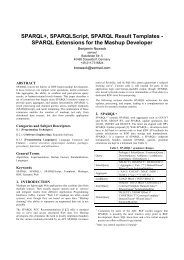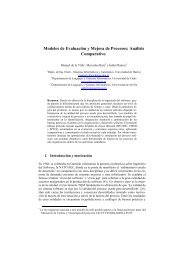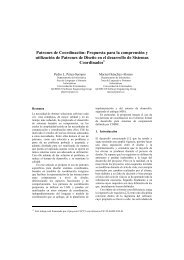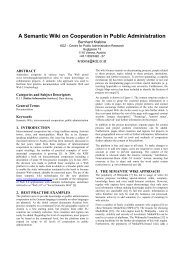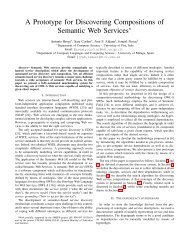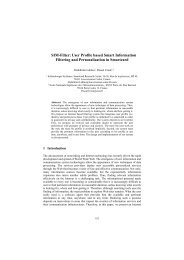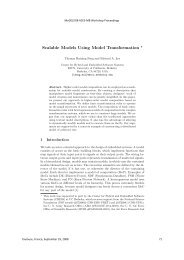ontology-based information extraction systems (obies 2008)
ontology-based information extraction systems (obies 2008)
ontology-based information extraction systems (obies 2008)
You also want an ePaper? Increase the reach of your titles
YUMPU automatically turns print PDFs into web optimized ePapers that Google loves.
Relation Validation via Textual Entailment<br />
Rui Wang 1 , Günter Neumann 2<br />
1 Saarland University, 66123 Saarbrücken, Germany<br />
rwang@coli.uni-sb.de<br />
2 LT-Lab, DFKI, Stuhlsatzenhausweg 3, 66123 Saarbrücken, Germany<br />
neumann@dfki.de<br />
Abstract. This paper addresses a subtask of relation <strong>extraction</strong>, namely<br />
Relation Validation. Relation validation can be described as follows: given an<br />
instance of a relation and a relevant text fragment, the system is asked to decide<br />
whether this instance is true or not. Instead of following the common<br />
approaches of using statistical or context features directly, we propose a method<br />
<strong>based</strong> on textual entailment (called ReVaS). We set up two different<br />
experiments to test our system: one is <strong>based</strong> on an annotated data set; the other<br />
is <strong>based</strong> on real web data via the integration of ReVaS with an existing IE<br />
system. For the latter case, we examine in detail the two aspects of the<br />
validation process, i.e. directionality and strictness. The results suggest that<br />
textual entailment is a feasible way for the relation validation task.<br />
Keywords: Relation Validation, Textual Entailment, Information<br />
Extraction<br />
1 Introduction and Relation Work<br />
Information <strong>extraction</strong> (IE) has been a hot topic for many years both in the area of<br />
natural language processing. An important task involved is relation <strong>extraction</strong>, which<br />
automatically identifies instances of certain relations of interest in some document<br />
collection, e.g. work_for(, , ).<br />
Conventional IE <strong>systems</strong> are usually domain-dependent and adapting the system to<br />
a new domain requires a high amount of manual labor, such as specifying and<br />
implementing relation-specific <strong>extraction</strong> patterns or annotating large amounts of<br />
training corpora. A new trend in <strong>information</strong> <strong>extraction</strong> is trying to collect <strong>information</strong><br />
directly from the web and “understand” it (Etzioni et al., 2005; Banko et al., 2007).<br />
One crucial point for such relation <strong>extraction</strong> <strong>systems</strong> is to be able to estimate the<br />
quality of the extracted instances. Web documents are relatively noisy compared with<br />
corpora constructed for particular usages. Therefore, a careful evaluation (or<br />
validation) step is needed after the <strong>extraction</strong> process.<br />
Another effort made by researchers developing unsupervised IE <strong>systems</strong>, e.g.<br />
Shinyama and Sekine (2006), Xu et al. (2007), and Downey et al. (2007). Here, the<br />
evaluation of those newly obtained instances with a good confidence score has a great<br />
impact on the final results (Agichtein, 2006). This also adds more burdens to, in our<br />
context, the validation module.



